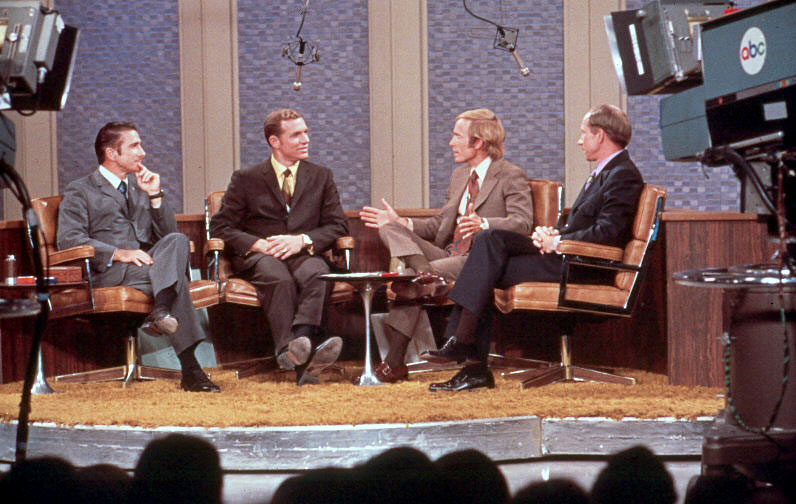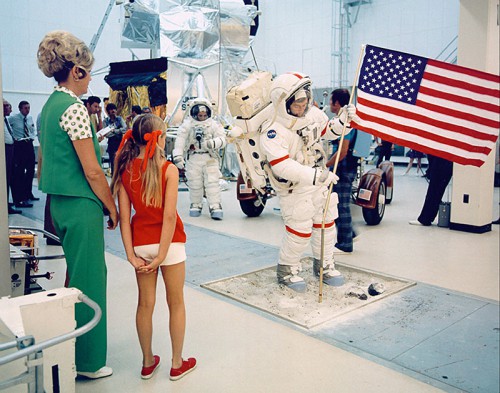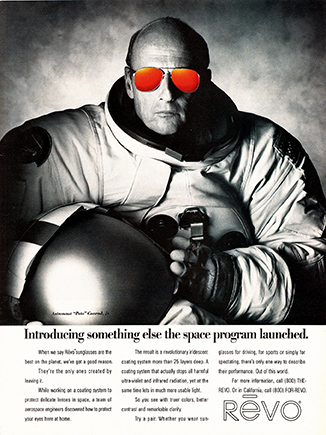
Unlike no other time in NASA’s history, people all over the world couldn’t get enough of the pioneering Mercury and Gemini flights, and, ultimately, the Apollo Moon landings. According to an overview of the book Marketing the Moon: The Selling of the Apollo Lunar Program (published by The MIT Press in February this year), “In July 1969, ninety-four percent of American televisions were tuned to coverage of Apollo 11’s mission to the Moon.” During this time, entire generations (including some future astronauts, cosmonauts, and space travelers) were inspired by these missions, which enjoyed wide press coverage on radio, by newspapers, and on television. The space agency and its contractors arguably “sold” the aims of The Space Race to the general public through the media, even encompassing advertising and glossy pieces enterprised in the time’s magazines, such as LIFE and Look.
Two youngsters transfixed by the grainy, ghostly images of Neil Armstrong and Buzz Aldrin walking on the Moon were David Meerman Scott and Richard Jurek. Marketing the Moon, written by Scott and Jurek, focuses on all aspects of this “marketing” siege from the genesis of The Space Race in the 1950s through the Apollo days. The book, with a foreword by Captain Eugene A. Cernan (Gemini 9A, Apollo 10, and Apollo 17 astronaut), features nearly 300 illustrations and images, some never published previously. It was created with the aim of presenting “a book that has the feel of a museum exhibit in your hands – with a strong, original narrative of previously unexplored stories, woven in with wonderful illustrations and side bar facts and stories that make reading the book a unique experience,” according to co-author Jurek.
AmericaSpace recently interviewed Jurek about Marketing the Moon, asking him about the inspiration for such a book, his favorite stories he heard while writing it, and what the future may hold in terms of “selling spaceflight.” Author’s note: Book spoilers ahead.
AmericaSpace: While there have been innumerable books discussing the Space Race, Apollo, and related topics, I can’t remember one that discussed the subject from a standpoint of marketing and pop culture. What influenced you and David Meerman Scott to put together such a book?
Richard Jurek: David and I are both children of the Apollo generation. We both grew up with a fascination and love for space, born of our experiences with the Apollo program. For me, the earliest memory I have as a child is of sitting on the green shag rug of my parents’ late-1960s living room, watching a Saturn V rocket on the launch pad on this big, wooden console black and white TV. Growing up, space was always a theme in my life—from the films of the era, to such things as the original Cosmos and the first NASA robotic missions to Mars. We were of the audience that NASA, the contractors, and the commercial product producers were marketing to during Apollo, and it left a lasting impression.

As professional marketers (click here to know more about them in detail), David and I have always been fascinated by the untold stories we would hear from astronauts or former NASA PAO folks we would meet at Astronaut Scholarship Foundation events and elsewhere. While others would ask the usual questions (you know, how do you go to the bathroom in space, etc.), we would ask questions such as: “Were you ever scripted by NASA what to say? Were you media trained? Did you have any input on the selection of off-the-shelf products like the Sony T-50 cassette recorder or the Omega watch? Did you get any kick-backs from Tang?” These kinds of questions. And we always got the most interesting and unique responses, and we heard stories that we had never read or heard elsewhere before.
So after many years of wishing there was a book about the topic, David and I finally decided to write it. We wanted to write it now, while these heroes of our youth—the astronauts, the NASA public affairs officials, and the contractor marketers—were still around and available for us to interview. We had already lost legends such as Julian Scheer and Paul Haney, so it was a labor of love to track down the original pioneers of space flight marketing and PR and hear their amazing stories and reflections. We felt we owed it to them to get the story right, and to focus on the many stories that had never been told before—to give a voice to this important side of the program that has been far too often overlooked.
AmericaSpace: I found there were some very funny, neat reminiscences about the Apollo era (especially the Conrad-Gordon-Young-Stafford singing quartet at Al Shepard’s party, and the excellent accompanying photo) in the book, told to you by former workers during that era. Did you have a favorite story in particular from that time that was relayed to you?
Jurek: There are so many wonderful stories in the book that it is hard to choose just one favorite! But two special stories really come to mind on first blush.
The first being the story of a young reporter at the time named Wayne Harrison, who worked for a small radio station in Texas that did not have a budget to send him to the Apollo 11 launch. So Harrison bartered his vacation days and traded on-air advertisements for a hotel room in order to cover the launch. His by-the-bootstraps stories of the press room and how he covered Apollo 11 always brings a smile to my face, when you consider he was one of just thousands of credentialed reporters covering the story of the century.
And, secondly, I am particularly fond of the 50-State Tour story as told by Ellwood Johnson, a contract employee to NASA MSC, who actually drove with the Apollo 11 capsule as it went on a state-by-state, year long Capitol tour—and the touching moment in which Neil Armstrong’s parents waited patiently in a long line in Ohio to get their first glimpse of the capsule that transported their son into the history books. A very touching and precious story of the humility and gentle nature of the Armstrong family, and one that probably never would have been told had we not written the book and talked to Mr. Johnson.
AmericaSpace: This book not only touches on the relationship NASA had to the press and its public affairs, but discusses how industry was affected by the Moon Race (it showed in advertisements from the era). What kinds of resonances do you think that era had on advertising/marketing in general, to this day, concerning spaceflight?
Jurek: It was an unprecedented public-private partnership that serves as a shining example for marketers and communicators today. It’s a classic case study of timeless techniques that are very informative for professional communicators today. During the great space race, NASA stood at the vanguard of what modern day marketers call real-time marketing and brand journalism, and they partnered with industry to split the duties and deal with the global crush of interest, especially during the buildup to and immediately following Apollo 11. NASA focused on the public affairs part of the task, and private industry focused on the more traditional marketing aspects. Together, they helped to ensure that the world was taken along for the ride with the astronauts as they traveled to, landed, and explored the Moon.
NASA hired ex-journalists to help them fulfill the communications mandate embedded in its charter, and this helped NASA PAO to serve up content in a form and a shape that could easily slip into the news streams of the day, as well as change the way in which NASA interacted with the media. NASA today carries on this great tradition with the amazing public outreach and public affairs work it does—especially with its award-winning social media programs. But back in the 1950s and 1960s, NASA and the contractors were truly doing pioneering real-time marketing and brand journalism work.
AmericaSpace: As I said before, many books have been written about Apollo, and I’m sure you and Mr. Scott have read a great many. Were there any things you both discovered that surprised you about that era while writing and researching this book?
Jurek: There are so many surprises and new details in the book—and that was really a fun part of the adventure in research and writing it. For me, it really does boggle the mind to think that during the height of the cold war—with so much at stake in the world, and the political posturing between the East and the West—that the astronauts were never scripted and were never media trained. Think about that. These guys were rock stars of their day. As Apollo 17 commander and moonwalker Gene Cernan so eloquently states in the foreword to the book, “We were marketing the United States of America.” And NASA, and the government, were brave enough to let these men speak their minds and freely communicate their experiences live, and in real time. It was an open program in the truest sense of the word, and while having TV cameras on-board or live audio feeds were not a foregone conclusion, there were enough brave souls within NASA and the PAO who pushed for this open access through out the program. We document their struggles and conflicts in the book.

Their efforts ultimately allowed all Americans and the world to experience the Moon landings as a global, communal event, and in a way that was in shocking contrast to the closed Soviet era program that was cloaked in secrecy. Success, as well as the ever-present tragedy and dangers of failure, such as experienced during the Apollo 1 fire, were equally presented and equally told—unvarnished, unedited, and unscripted. Apollo is not only an engineering and scientific triumph, but also a triumph of press and speech freedom as well.
AmericaSpace: Since the 1960s and 1970s, MUCH has changed in the way of mass media (especially with the addition of the Internet and social media). Do you think we’ll be seeing a sequel someday called “Marketing the ISS” or “Marketing Mars”? How would you tackle that?
Jurek: Much of the change in our relationship to mass media is a direct result of the Apollo program—the shrinking of cameras, the real-time broadcasting of events, the global communications networks that make live, real-time broadcasting possible. It is no coincidence that a company like Intel was formed in 1965 when the vast majority of computer chips in the country were being consumed by the space program, or that companies like Microsoft and Apple were formed in the mid ’70s by the very kids who were not only inspired by but also direct beneficiaries of the immense technological revolution that was spurned on by the Apollo space program.
Those smart phones in our pockets are, indeed, an enduring legacy of Apollo, as much as the images of those missions or the moon rocks themselves. As the technology has changed, so, too, has our relationship with it, and our expectations of what it means to have real-time access. NASA continues to do pioneering work in this field, and we hope that our book will lead to other books exploring this great legacy through the many great NASA programs that followed Apollo.
As passionate space enthusiasts, we wanted to capture and record this important aspect of Apollo as a tribute to the hundreds of men and women who worked tirelessly to communicate to the world about the American space program during Apollo. This is really their story, and we felt an obligation to get it right, and to present it in as much of an engaging and interesting way possible. We also wanted to write this book now, while many of the participants are still with us, in order to get their first-hand account of their contributions and achievements. We hope that the book will serve as a new avenue for other writers and researchers to explore in more detail in the years to come.
*****
Marketing the Moon: The Selling of the Apollo Lunar Program is available at all book retailers. For more information, check out the book’s page on The MIT Press’ website.
Many thanks to Richard Jurek for making this article possible.
Want to keep up-to-date with all things space? Be sure to “Like” AmericaSpace on Facebook and follow us on Twitter: @AmericaSpace



